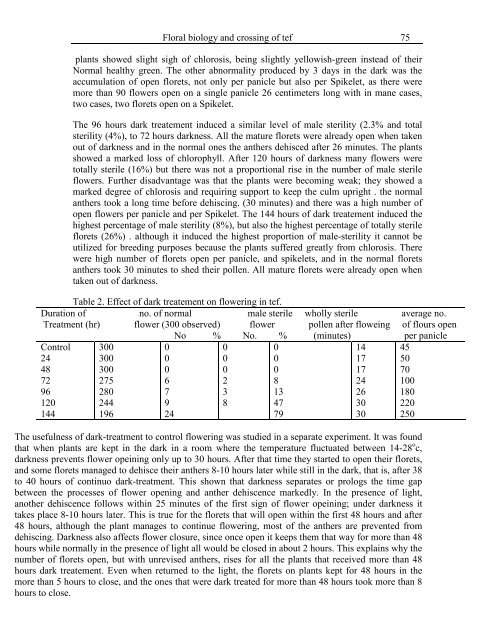Teff Reaserch and Development - Official web site of Etteff
Teff Reaserch and Development - Official web site of Etteff
Teff Reaserch and Development - Official web site of Etteff
Create successful ePaper yourself
Turn your PDF publications into a flip-book with our unique Google optimized e-Paper software.
Floral biology <strong>and</strong> crossing <strong>of</strong> tef 75<br />
plants showed slight sigh <strong>of</strong> chlorosis, being slightly yellowish-green instead <strong>of</strong> their<br />
Normal healthy green. The other abnormality produced by 3 days in the dark was the<br />
accumulation <strong>of</strong> open florets, not only per panicle but also per Spikelet, as there were<br />
more than 90 flowers open on a single panicle 26 centimeters long with in mane cases,<br />
two cases, two florets open on a Spikelet.<br />
The 96 hours dark treatement induced a similar level <strong>of</strong> male sterility (2.3% <strong>and</strong> total<br />
sterility (4%), to 72 hours darkness. All the mature florets were already open when taken<br />
out <strong>of</strong> darkness <strong>and</strong> in the normal ones the anthers dehisced after 26 minutes. The plants<br />
showed a marked loss <strong>of</strong> chlorophyll. After 120 hours <strong>of</strong> darkness many flowers were<br />
totally sterile (16%) but there was not a proportional rise in the number <strong>of</strong> male sterile<br />
flowers. Further disadvantage was that the plants were becoming weak; they showed a<br />
marked degree <strong>of</strong> chlorosis <strong>and</strong> requiring support to keep the culm upright . the normal<br />
anthers took a long time before dehiscing. (30 minutes) <strong>and</strong> there was a high number <strong>of</strong><br />
open flowers per panicle <strong>and</strong> per Spikelet. The 144 hours <strong>of</strong> dark treatement induced the<br />
highest percentage <strong>of</strong> male sterility (8%), but also the highest percentage <strong>of</strong> totally sterile<br />
florets (26%) . although it induced the highest proportion <strong>of</strong> male-sterility it cannot be<br />
utilized for breeding purposes because the plants suffered greatly from chlorosis. There<br />
were high number <strong>of</strong> florets open per panicle, <strong>and</strong> spikelets, <strong>and</strong> in the normal florets<br />
anthers took 30 minutes to shed their pollen. All mature florets were already open when<br />
taken out <strong>of</strong> darkness.<br />
Table 2. Effect <strong>of</strong> dark treatement on flowering in tef.<br />
Duration <strong>of</strong> no. <strong>of</strong> normal male sterile wholly sterile average no.<br />
Treatment (hr) flower (300 observed) flower pollen after floweing <strong>of</strong> flours open<br />
Control<br />
24<br />
48<br />
72<br />
96<br />
120<br />
144<br />
300<br />
300<br />
300<br />
275<br />
280<br />
244<br />
196<br />
0<br />
0<br />
0<br />
6<br />
7<br />
9<br />
24<br />
No % No. % (minutes) per panicle<br />
The usefulness <strong>of</strong> dark-treatment to control flowering was studied in a separate experiment. It was found<br />
that when plants are kept in the dark in a room where the temperature fluctuated between 14-28 o c,<br />
darkness prevents flower opeining only up to 30 hours. After that time they started to open their florets,<br />
<strong>and</strong> some florets managed to dehisce their anthers 8-10 hours later while still in the dark, that is, after 38<br />
to 40 hours <strong>of</strong> continuo dark-treatment. This shown that darkness separates or prologs the time gap<br />
between the processes <strong>of</strong> flower opening <strong>and</strong> anther dehiscence markedly. In the presence <strong>of</strong> light,<br />
another dehiscence follows within 25 minutes <strong>of</strong> the first sign <strong>of</strong> flower opeining; under darkness it<br />
takes place 8-10 hours later. This is true for the florets that will open within the first 48 hours <strong>and</strong> after<br />
48 hours, although the plant manages to continue flowering, most <strong>of</strong> the anthers are prevented from<br />
dehiscing. Darkness also affects flower closure, since once open it keeps them that way for more than 48<br />
hours while normally in the presence <strong>of</strong> light all would be closed in about 2 hours. This explains why the<br />
number <strong>of</strong> florets open, but with unrevised anthers, rises for all the plants that received more than 48<br />
hours dark treatement. Even when returned to the light, the florets on plants kept for 48 hours in the<br />
more than 5 hours to close, <strong>and</strong> the ones that were dark treated for more than 48 hours took more than 8<br />
hours to close.<br />
0<br />
0<br />
0<br />
2<br />
3<br />
8<br />
0<br />
0<br />
0<br />
8<br />
13<br />
47<br />
79<br />
14<br />
17<br />
17<br />
24<br />
26<br />
30<br />
30<br />
45<br />
50<br />
70<br />
100<br />
180<br />
220<br />
250


